Vein conditions can affect your legs and other areas of the body. Depending on the disorder, you may experience venous insufficiency symptoms such as pain, itching, burning, swelling or throbbing.
To diagnose the problem, your doctor may perform an assessment and an ultrasound scan to determine how well your circulatory system is functioning. You may be diagnosed with varicose veins or one of the following conditions:
Spider Veins
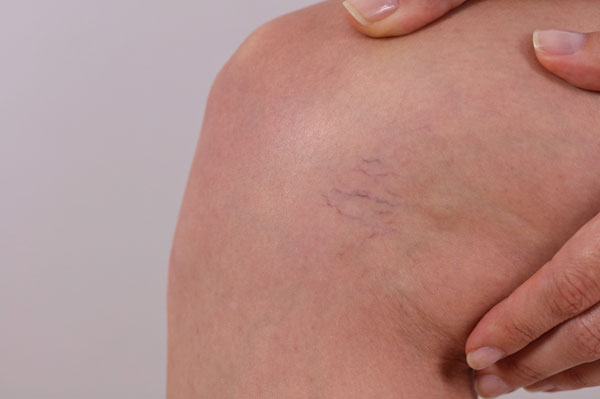
What is it?: Spider veins are the mildest form of venous insufficiency. The tiny, string-like damaged veins, can appear on the surface of the skin. These are most typically found on the face or legs.
Appearance: Spider veins can be flat or slightly raised and form under the skin as wavy lines, webs or branches. They can appear as red, purple, or dark blue.
Symptoms: Although spider veins can cause some discomfort, they are painless most of the time. Since they’re easily visible through the skin, some patients may wish to have them treated for cosmetic reasons.
Reticular Veins
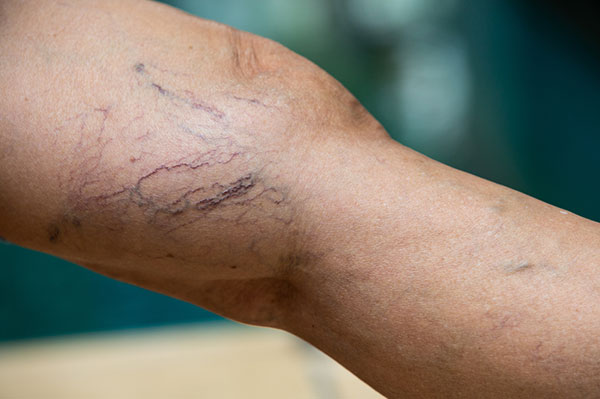 What is it?: Reticular veins are the middle ground between varicose veins and spider veins. They tend to be smaller (2mm in diameter) and don’t bulge from the skin’s surface as much as varicose veins. Reticular veins are typically located on the back of the thighs, lower legs and ankles.
What is it?: Reticular veins are the middle ground between varicose veins and spider veins. They tend to be smaller (2mm in diameter) and don’t bulge from the skin’s surface as much as varicose veins. Reticular veins are typically located on the back of the thighs, lower legs and ankles.
Appearance: Mostly flat and bluish in colour, these vessels often form a complex venous network that can feed into smaller spider veins. For this reason, medical professionals refer to them as “feeder veins.”
Symptoms: Similar to varicose veins, reticular veins can cause pain and discomfort. This includes itching, burning and swelling. In some cases, the presence of reticular veins can indicate a more serious venous condition such as a blood clot.
Bulging Veins
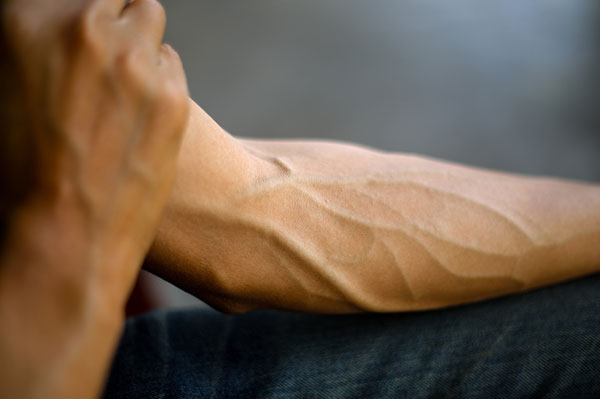 What is it? Bulging veins are as they sound: veins which bulge from the skin. While they can be bothersome, they are usually not harmful. There are a number of reasons why veins can appear. These include:
What is it? Bulging veins are as they sound: veins which bulge from the skin. While they can be bothersome, they are usually not harmful. There are a number of reasons why veins can appear. These include:
- Strength training: physical activity like lifting weights demands a lot more blood for the muscles, which can make it difficult for veins to move blood to the heart. Additionally, the more muscle you build, the closer your veins run to the skin.
- Genetics: thinner and paler skin makes veins more visible, as does less fat. You may also be born with naturally larger veins.
- Ageing: the older we get, the more wear and tear our veins experience. Over time, vein walls and valves may get weaker, and the skin starts losing its elasticity.
Appearance: Bulging veins, protrude from the skins surface and can be bluish in colour or have no colour. They are often found in your hands, arms or face. It is possible that they could be confused with varicose veins, if you see twisted bulging veins or experience any symptoms, have them assessed by a medical practitioner.
Symptoms: There shouldn’t be any symptoms accompanying bulging veins. If you do experience any accompanying symptoms, please consult a medical practitioner.
Venous Ulcers
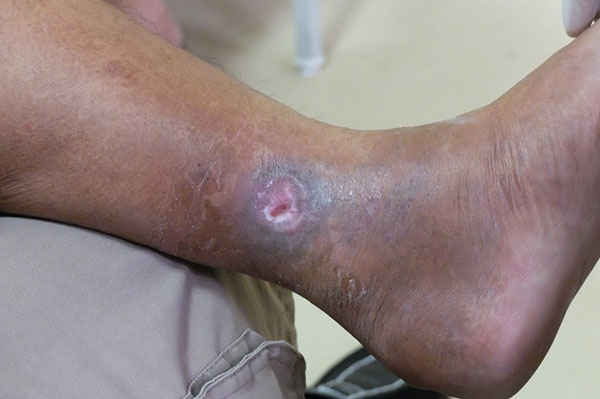 What is it?: Venous ulcers are large wounds on the skin. They develop when faulty valves increase pressure inside the vein. This pressure causes blood proteins and blood cells to leach into the surrounding tissue. If left untreated, this tissue can start to break down due to loss of nutrients and being deprived of oxygen.
What is it?: Venous ulcers are large wounds on the skin. They develop when faulty valves increase pressure inside the vein. This pressure causes blood proteins and blood cells to leach into the surrounding tissue. If left untreated, this tissue can start to break down due to loss of nutrients and being deprived of oxygen.
Appearance: In the early stages of venous ulcers, scaling, redness and inflammation can occur in the affected area. The skin can also take on a yellow, brownish appearance. Over time, as the blood leaks into the subcutaneous tissue, skin can appear dark red or purple.
Symptoms: These can range from no discomfort at all to becoming painful if an infection develops. Venous ulcers are frequently accompanied by inflammation, swelling, itchiness, discharge, flaking, and hard or discoloured skin.
Deep Vein Thrombosis
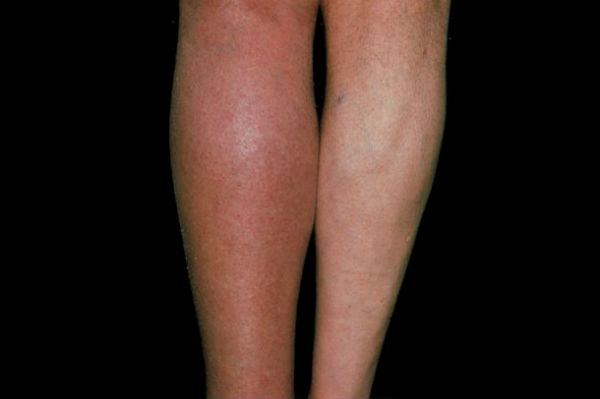 What is it?: Deep vein thrombosis (DVT) can appear on its own or with other vein conditions. Essentially, it is a blood clot that forms deep in the veins, most commonly in the legs. DVT can be dangerous since the blood clots can break away, travel through the circulatory system and become lodged in the lungs – known as a pulmonary embolism.
What is it?: Deep vein thrombosis (DVT) can appear on its own or with other vein conditions. Essentially, it is a blood clot that forms deep in the veins, most commonly in the legs. DVT can be dangerous since the blood clots can break away, travel through the circulatory system and become lodged in the lungs – known as a pulmonary embolism.
Appearance: blood clots aren’t visible to the naked eye. Therefore, doctors look for related DVT signs, such as swelling in your foot, ankle or leg, an area that feels warmer than the surrounding skin, or an affected area which has turned pale, reddish or bluish.
Symptoms: Deep vein thrombosis can have no symptoms, which is why it’s so dangerous. In many cases, however, the body gives signs such as pain, cramping or swelling in the affected leg.
Phlebitis
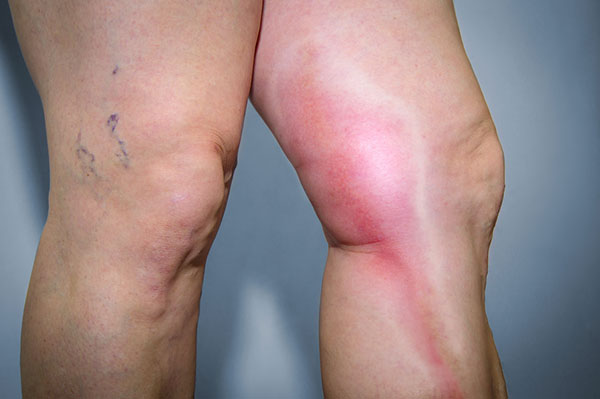 What is it?: Phlebitis is the inflammation of a vein, occurring superficially or deep inside the vein. This condition can result from injury or irritation to the lining of a blood vessel. Superficial phlebitis affects blood vessels closer to the skin, whereas deep phlebitis is found in larger veins, such as those in your legs.
What is it?: Phlebitis is the inflammation of a vein, occurring superficially or deep inside the vein. This condition can result from injury or irritation to the lining of a blood vessel. Superficial phlebitis affects blood vessels closer to the skin, whereas deep phlebitis is found in larger veins, such as those in your legs.
Appearance: The affected area can appear swollen. It will also usually be warm to the touch and develop visible red streaking.
Symptoms: Some patients experience no symptoms. Doctors look out for DVT symptoms such as swelling, redness, warmth, tenderness and rope-like structures that can be detected through the skin. Some patients experience no symptoms.
Pelvic Congestion Syndrome
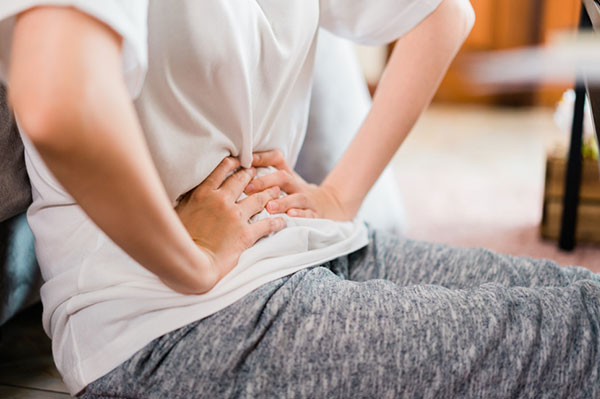 What is it?: Pelvic congestion syndrome is characterised by chronic pain in the pelvic region due to faulty veins and pooling of blood in the lower abdomen. This condition tends to affect women of childbearing age, particularly those who have given birth to multiple children. It can affect up to 1 in 3 women.
What is it?: Pelvic congestion syndrome is characterised by chronic pain in the pelvic region due to faulty veins and pooling of blood in the lower abdomen. This condition tends to affect women of childbearing age, particularly those who have given birth to multiple children. It can affect up to 1 in 3 women.
Appearance: PCS isn’t visible to the naked eye. To diagnose this disorder, doctors perform an ultrasound scan to check for varicose veins in the pelvis. However, you may need another imaging test such as a venography to confirm the diagnosis.
Symptoms: Pain is the primary symptom of pelvic congestion syndrome. It can be chronic (long-term) – lasting six months or longer. Often starting during or after a pregnancy, the pain may be sharp or dull, occurring on one or both sides. The pain can also intensify towards the end of the day.
Vulva Veins
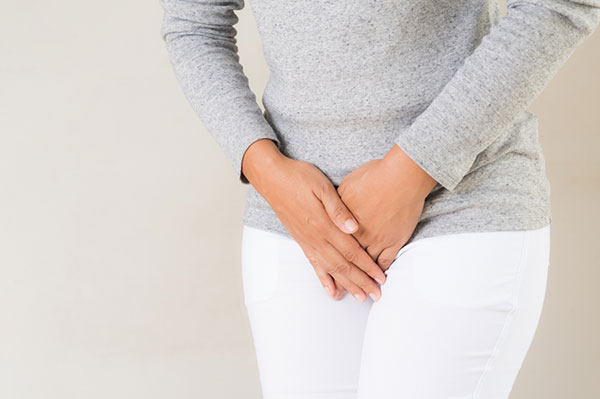 What is it?: Vulva veins are essentially varicose veins that appear on the genitals, most often in pregnant women. Increased blood volume during pregnancy exerts extra pressure on the veins in the legs and vulva, leading to the formation of vulva veins.
What is it?: Vulva veins are essentially varicose veins that appear on the genitals, most often in pregnant women. Increased blood volume during pregnancy exerts extra pressure on the veins in the legs and vulva, leading to the formation of vulva veins.
Appearance: Vulva veins can appear dilated, bulging and bluish.
Symptoms: In most women, vulva veins don’t produce any symptoms. In others, symptoms may include feeling fullness or pressure in the vulvar area, swelling, pain and discomfort. Additionally, prolonged standing and physical activity can make the condition worse.
Lymphoedema
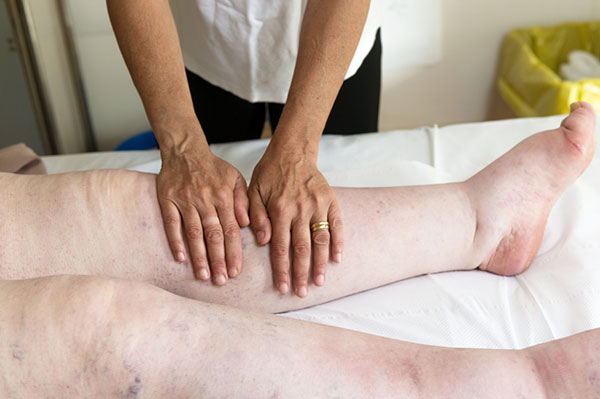 What is it?: Lymphoedema is a chronic condition causing extreme swelling of the tissues. It can occur in just one area, such as the arms or legs, or develop into a systemic problem affecting the entire body. Lymphoedema occurs when the lymph vessels can’t drain adequately.
What is it?: Lymphoedema is a chronic condition causing extreme swelling of the tissues. It can occur in just one area, such as the arms or legs, or develop into a systemic problem affecting the entire body. Lymphoedema occurs when the lymph vessels can’t drain adequately.
Appearance: Lymphoedema presents as excessive limb swelling, making it difficult to fit into clothes and wear jewellery.
Symptoms: Swelling is often accompanied by a ‘heavy’ feeling, difficulty moving, chronic skin infections and fluid leakage, skin tightness and folds developing in the skin.